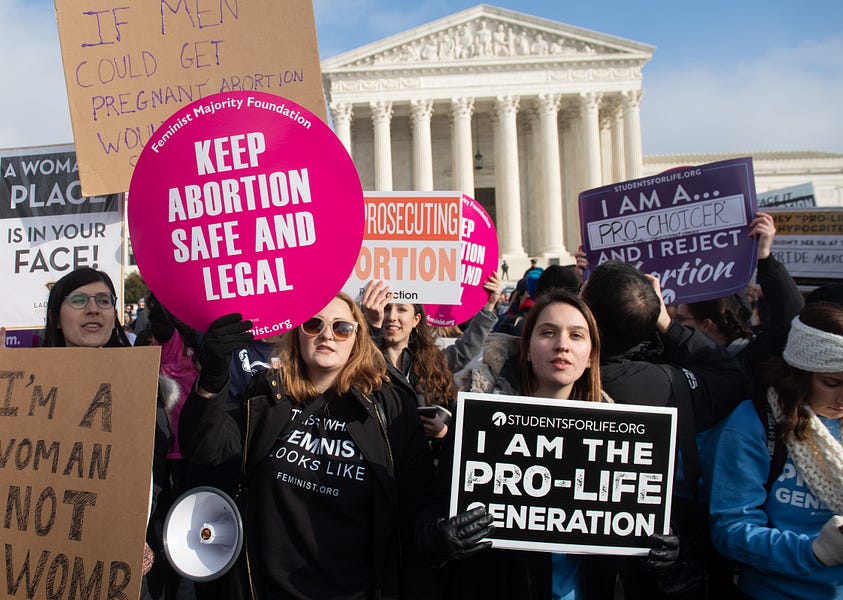If you want to know a key reason why the American culture war has run so hot, it’s because the answer to many of the most contentious questions in American constitutional law has been a single sentence: “We don’t know.”
Are Christian charities (such as hospitals and adoption agencies) that provide state-regulated services to the public bound by state nondiscrimination laws even when those nondiscrimination laws conflict with the teachings of the church? We don’t know.
Can states still use historically anti-Catholic Blaine Amendments to bar state funding for churches, church schools, and other religious organizations merely because they’re religious? We don’t know.
Do existing federal nondiscrimination statutes protect gay and/or transgender Americans from employment discrimination in secular workplaces? We don’t know.
Are Christian schools bound by nondiscrimination laws in their treatment of employees who perform religious functions but don’t carry the title of “minister,” “priest,” or “pastor”? We don’t know.
And here’s the big one …
Will the new post-Kennedy court meaningfully adjust its abortion jurisprudence, or will it continue to broadly follow Planned Parenthood v. Casey by striking down state laws that impose an “undue burden” on abortion rights? We don’t know.
Each link above is to a Supreme Court case that’s been argued this term, will be argued this term, or is set to be argued likely later this year. With the exception of the abortion case (which I’ll address in a moment), the cases mainly pertain to the most controversial conflict in modern First Amendment jurisprudence—the clash between religious liberty, free speech, and nondiscrimination statutes.
For example, in both Fulton v. City of Philadelphia and Our Lady of Guadalupe School v. Morrissey-Beru, private religious entities (Catholic Social Services in Philadelphia and a Catholic school in California) seek protection from local and state nondiscrimination laws. In Fulton, the city of Philadelphia punished Catholic Social Services because CSS “cannot provide written endorsements for same-sex couples which contradict its religious teachings on marriage.”
Our Lady of Guadalupe is a different variation on the same thing. The school seeks to extend the “ministerial exception” to employment nondiscrimination laws to cover employees who perform ministerial functions, regardless of whether they hold the title of pastor or minister, so long as they perform “important religious functions.”
The Blaine Amendment case, Espinoza v. Department of Revenue, flips the discrimination calculus on its head. This time, the issue isn’t whether the religious institution can discriminate against a member of the public, but whether the state can discriminate against a religious institution. The Montana Supreme Court invalidated a private school aid program because it included religious schools, holding that the program violated a state constitutional provision that specifically singles out and prohibits any “direct or indirect appropriation” for “any sectarian purpose or to aid any church, school, academy, seminary, college, university … controlled in whole or in part by any church, sect, or denomination.”
When conservatives speak of “religious freedom under fire,” cases like these are exactly what we’re talking about.
Here’s why: While there are certainly many good-faith and serious arguments as to why or why not religious organizations should be able to discriminate (and religious organizations have wildly different nondiscrimination policies—not all churches are alike), the idea that the state should step in and settle church nondiscrimination policy (or condition participation in state programs on state nondiscrimination policies) would represent an inversion of the constitutional order.
Put simply, the Constitution (including the Bill of Rights) sits at the apex of American law. That doesn’t mean that there aren’t instances where federal and state laws can’t limit the exercise of constitutional rights, but the general principle is clear—the First Amendment trumps statutes and regulations.
As nondiscrimination laws expand, however, they come into increasing conflict with religious freedom, including longstanding religious doctrines. The rules governing commercial establishments have been relatively clear for decades—in the absence of extraordinary circumstances, there is no First Amendment right to refuse a person service on the basis of protected characteristics.
But how much can those rules intrude into the conduct of religious organizations themselves? It’s one thing to tell a restaurant manager that he can’t deny a burger and fries to a gay couple. It’s another thing entirely to tell the Catholic Church that its social service agencies must place children with gay couples. In one instance, the state is regulating a secular business. In the other instance, the state is attempting to expand its regulation of the church itself.
I say “expand” because churches obviously don’t (and shouldn’t) enjoy absolute autonomy. To take an extreme example, an act of human sacrifice is still murder even if undertaken as part of a religious ritual. A pastor can’t steal from his parishioners and claim religious protection for taking his “tithe.” Yet the existence of some limits doesn’t create a permission structure for just any limits, and the primacy of the First Amendment means that the state should bear a heavy burden of justification (for example, controlling a pandemic) before it can expand its regulation of core religious activities.
In fact, clipping back state attempts to control (or punish) church policies may well cool the American culture wars. If much conflict is driven by legitimate conservative religious concern that its churches, charities, and schools are going to face increasing state supervision (and state sanction), putting up a version of a judicial “no trespassing” sign could go a long way toward easing the temptation offered by “end of liberty” alarmism that dominates much of our political discourse.
At the same time, however, even as the court limits the enforcement of nondiscrimination law in religious institutions, there’s a real possibility that it may well expand their reach in secular workplaces. In both Bostock v. Clayton County and R.G. & G.R. Harris Funeral Homes, Inc. v. EEOC, the court is answering a similar question: Does Title VII’s prohibition on discrimination on the basis of “sex” also bar discrimination on the basis of sexual orientation and gender identity?
Before the oral arguments in the case, the conventional wisdom seemed set. A conservative majority was going to hold that “sex” meant “sex” and not sexual orientation and gender identity. After all, there’s no real argument that the drafters of Title VII intended the scope of the statute to be so broad.
After oral arguments, however, observers are not quite so sure. The court seemed quite curious about the assertion that discrimination on the basis of sexual orientation and gender identity was actually and truly sex discrimination. The reason? A concept called “sex stereotyping.”
If you fire a person because they are transgender, is the true reason their gender identity or their failure to conform to presumptions about how members of their sex should act? The same argument applies to sexual orientation. If you fire a person because he or she is gay, is the offense their homosexuality or their failure to conform to presumed appropriate behaviors on the basis of sex?
Or to put the argument another way, “If a male employee is fired because he has sexual relationships with men, but female employees in the same workplace can have sexual relationships with men without getting fired, then the male employee was fired ‘because of [his] sex,’ inasmuch as he would not have been fired had his sex been different.”
The cases set up a potential (and fascinating) conflict between textualism and originalism. No one believes Title VII was intended to ban discrimination on the basis of sexual orientation and gender identity, but the words on the page are the words on the page, and the textualist believes that the words control if their meaning is clear.
If, for example, Justice Gorsuch takes a textualist approach, that doesn’t necessarily mean the gay and transgender litigants win (there is still a fierce battle over the proper textualist interpretation), but textualism gives them a fighting chance that originalism does not.
By the end of the next SCOTUS term, we may see an interesting new “wall of separation” between church and state—with secular and religious institutions facing very different nondiscrimination obligations.
Finally, let’s deal with the abortion case, June Medical Services v. Russo. It’s an almost-perfect test case for the post-Kennedy court. Here’s why:
In 2016, the court struck down a Texas law that required abortion doctors to hold admitting privileges at a hospital located within 30 miles of the abortion clinic. The court decided the case, Whole Women’s Health v. Hellerstedt, by a 5-3 margin (the decision came after Justice Scalia’s death and before his replacement).
In 2018, the 5th Circuit Court of Appeals unexpectedly upheld Louisiana’s admitting privileges law, which also required abortion doctors to hold admitting privileges at a hospital located within 30 miles of the abortion clinic. The court found that under the specific facts applicable to the Louisiana law, it did not violate Whole Women’s Health. (For example, the Texas law would have caused all but eight of Texas’s 40 abortion clinics to close, whereas only one Louisiana abortion doctor was unable to obtain privileges.)
Let’s make this as simple as possible, if the court upholds Whole Women’s Health—even if it also upholds the Louisiana law as factually distinct and less burdensome than the Texas law—then that sends a clear signal that the court is not interested in any substantial changes in abortion jurisprudence. Why? Because if it upholds Whole Women’s Health, it will almost certainly reaffirm the Casey standard. It will reaffirm that abortion laws will be struck down if they impose an “undue burden” on abortion rights. That would mean that the pro-life movement is potentially just as far from a substantial change in abortion jurisprudence as it’s ever been. Upholding Whole Women’s Health would mean that even the most recent and minor of abortion rights precedents is safe, and only small tweaks to the regulatory framework are permissible.
I don’t know what the future holds. To the extent that I’d place a bet, I’ll bet that SCOTUS proves most hospitable to the religious liberty cases before it. But there’s also a very real chance that the court can shake up the culture war in a way that entirely pleases neither side of the ideological divide. Expanded religious liberty protections could be paired with expanded nondiscrimination obligations for secular employers and something that looks a lot like the abortion status quo.
If that happens, those who vote for presidents under the presumption that pressing the voting lever guarantees not just preferable judicial philosophies but also favorable judicial outcomes may find their expectations frustrated yet again.
One last thing …
I can’t get enough of The Last Dance and the flashback to a time when Magic, Larry, and Michael were all still playing basketball. One of the greatest moments of that marvelous time was the legendary Dream Team pickup game between Team Michael and Team Magic. It represented the passing of the torch. Here’s a look back:
Photograph Saul Loeb/AFP/Getty Images.







Please note that we at The Dispatch hold ourselves, our work, and our commenters to a higher standard than other places on the internet. We welcome comments that foster genuine debate or discussion—including comments critical of us or our work—but responses that include ad hominem attacks on fellow Dispatch members or are intended to stoke fear and anger may be moderated.
With your membership, you only have the ability to comment on The Morning Dispatch articles. Consider upgrading to join the conversation everywhere.